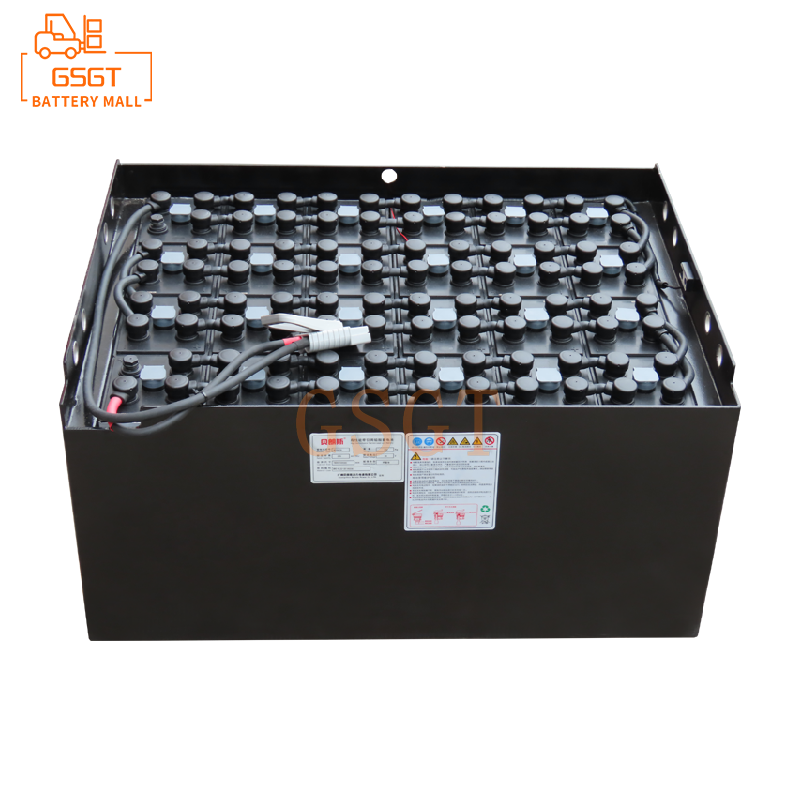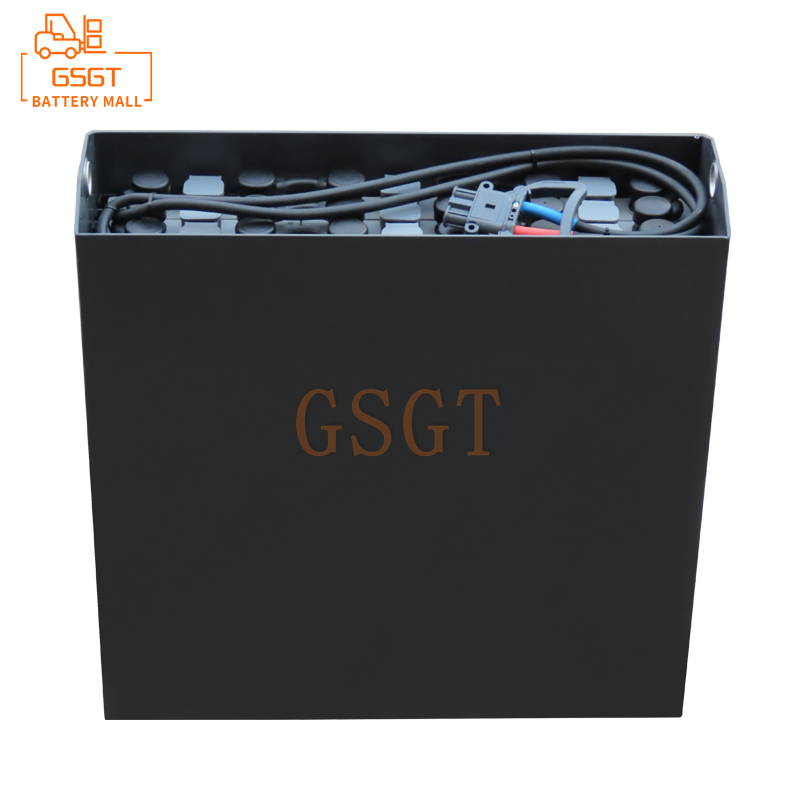Time:2025-07-22 11:01:31
Browse:616
In industrial production, as an important material handling equipment, the lead-acid battery, one of the power sources of forklifts, plays a key role in the stable operation of forklifts. The correct and safe use of lead-acid batteries not only ensures the personal safety of operators, extends the service life of the batteries, but also guarantees the efficient operation of forklifts and enhances overall production efficiency. The following is a detailed introduction to the safety usage regulations of lead-acid batteries for forklifts.
1. Working Principle and Characteristics of Lead-Acid Batteries
Lead-acid batteries are mainly composed of positive plates, negative plates, electrolyte (dilute sulfuric acid solution), separators and battery cases, etc. During charging, electrical energy is converted into chemical energy for storage. Lead sulfate on the positive plate is transformed into lead dioxide, and lead sulfate on the negative plate is converted into spongy lead. When discharging, the opposite is true. Chemical energy is converted into electrical energy, providing power for forklifts. Its characteristics determine that some key points need to be paid special attention to during use. For instance, lead-acid batteries will produce hydrogen and oxygen during charging and discharging. Hydrogen is flammable and explosive, which imposes strict requirements on the usage environment.
2. Inspection and Preparation Before Use
(1) Visual inspection
Before each use of the forklift, carefully inspect the appearance of the battery. Check if the battery casing is cracked, deformed or leaking. If any of these conditions are found, stop using it immediately and contact professionals for replacement or repair. Damage to the battery casing may lead to electrolyte leakage. The electrolyte is highly corrosive and can cause serious harm to personnel and equipment. At the same time, check the connection parts of the battery to ensure that the connection wires are firm, without any signs of loosening or corrosion. The terminal posts should be clean and free of oxide accumulation; otherwise, it will affect the battery's conductivity, reduce the power output of the forklift, and even cause a fire.
(2) Electrolyte inspection
Checking the electrolyte level is a crucial step. For non-maintenance-free batteries, the liquid level should be maintained at 10-15mm above the plates. Low liquid level will expose the plates to the air, accelerate their sulfation and shorten the battery life. If the liquid level is too high, during the charging process, the electrolyte is prone to overflow, corroding the battery and forklift components. When the liquid level is insufficient, only distilled water or deionized water can be added. It is strictly forbidden to add tap water or sulfuric acid solution. Impurities in tap water can affect the chemical reactions inside the battery, and adding sulfuric acid solution at will will change the specific gravity of the electrolyte and damage the battery. So how can we determine whether the specific gravity of the electrolyte is normal? Generally speaking, when measured with an intake hydrometer, under normal circumstances, the specific gravity of the electrolyte in lead-acid batteries is around 1.28 (at 25℃). If the specific gravity deviates too much, it indicates that there might be a problem with the battery and further inspection is needed.
(3) Inspection of charging environment
The charging area should be selected in a well-ventilated place. This is because hydrogen gas is produced during the charging of lead-acid batteries. If it accumulates in a confined space and encounters open flames or sparks, it is very likely to cause an explosion. At the same time, the charging area should be kept away from flammable and explosive items. Smoking or using open flame equipment is strictly prohibited nearby. In addition, the temperature of the charging environment is also crucial. The suitable temperature range is between 15 and 30 degrees Celsius. When the temperature is too low, the battery's charging acceptance capacity decreases, the charging time is prolonged, and it may not be fully charged. Excessively high temperatures will accelerate battery water loss and plate aging, thereby shortening battery life. If charging is carried out in a high-temperature environment, appropriate cooling measures can be taken, such as installing an air conditioner or fan.
3. Charging Operation Specifications
(1) Charging connection sequence
When connecting the charger, first connect the charger's plug to the battery's charging port to ensure a firm connection, and then turn on the power of the charger. After charging is complete, the operation sequence is reversed. First, disconnect the power supply of the charger, wait for a moment, and after the internal capacitor of the charger has completely discharged, then unplug the battery end. This sequence of operations can effectively prevent the generation of electric sparks when plugging and unplugging the plug, which could cause a hydrogen explosion.
(2) Control of charging duration
Lead-acid batteries should follow the principle of "shallow discharge and frequent charging" to avoid over-discharge. When the battery power drops below 20%, it should be charged in time. The single charging time is generally 8 to 10 hours. Once fully charged, charging should be stopped immediately to prevent overcharging. Overcharging will cause the battery to heat up, release gas, accelerate the drying up of the electrolyte and the aging of the plates, and seriously shorten the battery life. Some users asked if the charging time could be extended to make the battery charge more fully. The answer is no. The harm caused by overcharging far outweighs the benefits of charging a little more electricity. Moreover, the charging characteristics of different battery models may vary slightly. It is necessary to strictly follow the charging operation manual provided by the battery manufacturer.
(3) Monitoring of the charging process
During the charging process, the status of the battery needs to be closely monitored. Regularly check if the battery has any abnormal heating phenomenon. Under normal circumstances, the battery temperature should not exceed 45℃. If the temperature is too high, charging should be stopped immediately. Check whether the charger is working properly and whether there are any internal short circuits or other problems with the battery. At the same time, pay close attention to whether the battery has any strange smell or smoke. Once any abnormality is detected, quickly cut off the power supply and take corresponding fire extinguishing measures, such as using a dry powder fire extinguisher to put out the fire. Do not use water to put out the fire, as the electrolyte will splash when it comes into contact with water, increasing the danger. In addition, forklifts are strictly prohibited from being used during charging to prevent battery overload, which may affect battery life and the normal operation of the forklift.
4. Key Points for Daily Maintenance
(1) Cleaning and maintenance
Keeping the battery surface clean and dry is an important part of daily maintenance. Dust, impurities and residual electrolyte on the battery surface may cause leakage and even lead to short circuits. When cleaning, wipe the battery surface with a damp cloth. Do not use a dry cloth or brush to prevent static electricity from causing an explosion. For the oxide on the terminal posts, they can be rinsed with warm water and then protected by applying an appropriate amount of vaseline to maintain the good electrical conductivity of the terminal posts. So, how often is it appropriate to clean? It is generally recommended to conduct a comprehensive cleaning at least once a week. For forklifts used in harsh environments, the cleaning frequency should be appropriately increased.
(2) Regular inspection
In addition to daily appearance and electrolyte checks, more in-depth inspections of the battery are also required on a regular basis. For instance, check the tightness of the battery connection strips once a month to ensure a firm connection and prevent an increase in contact resistance due to loosening, which could affect battery performance. Check the internal resistance and capacity of the battery every 3 to 6 months. If it is found that the internal resistance of the battery has significantly increased or the capacity has decreased considerably, the cause should be analyzed in time and corresponding measures should be taken, such as equalizing charging or replacing the battery. In addition, it is necessary to check whether the safety valve of the battery is working properly. If the safety valve is blocked, the gas produced during charging cannot be discharged, which will cause the internal pressure of the battery to rise and pose an explosion risk.
(3) Storage Precautions
If a forklift is not used for a long time, there are also certain considerations for the storage of the battery. The battery should be fully charged first, and then a supplementary charge should be carried out every 1 to 2 months to prevent self-discharge and loss of power. When a battery is in a state of low charge, the plates are prone to sulfation, which greatly shortens the battery's lifespan. The environment for storing batteries should be dry and well-ventilated, avoiding direct sunlight, and the temperature should not be too high or too low. At the same time, the battery should be disconnected from the forklift to prevent small current discharge.
5. Emergency Response Measures
(1) Electrolyte leakage
If leakage of battery electrolyte is detected, immediate measures should be taken. First of all, operators should wear protective equipment properly, such as rubber gloves, protective glasses and aprons, etc. Then, neutralize the leaked electrolyte with alkaline substances such as lime, strong sodium bicarbonate or sodium bicarbonate. During the neutralization process, handle with care to avoid contact between the alkaline substances and the skin. After neutralization, rinse the leakage area with a large amount of clean water to ensure there is no residual electrolyte. If the electrolyte accidentally splashes onto the skin, rinse immediately with plenty of water for more than 15 minutes and seek medical attention as soon as possible. If it splashes into the eyes, rinse immediately with plenty of water and go to the hospital for professional treatment as soon as possible. Do not delay.
(2) Battery fire
Once a battery catches fire, stay calm and take prompt measures to extinguish the fire. For lead-acid battery fires, dry powder fire extinguishers (such as ABC type) should be used to put out the fire. Do not use water or carbon dioxide fire extinguishers. Because water can cause the electrolyte to splash and expand the fire, carbon dioxide fire extinguishers are not very effective in extinguishing lead-acid battery fires. During the fire extinguishing process, pay attention to your own safety and avoid inhaling smoke and toxic gases.
The safety usage regulations for lead-acid batteries in forklifts cover multiple aspects from pre-use inspection, charging operation, daily maintenance to emergency handling. Only by strictly adhering to these norms can the safe and efficient operation of forklift lead-acid batteries be ensured, providing reliable power support for industrial production.

$1060

$5710

$1690

$1200

MESSAGE
Professional And Efficient
Security
Affordable Price
Professional Services